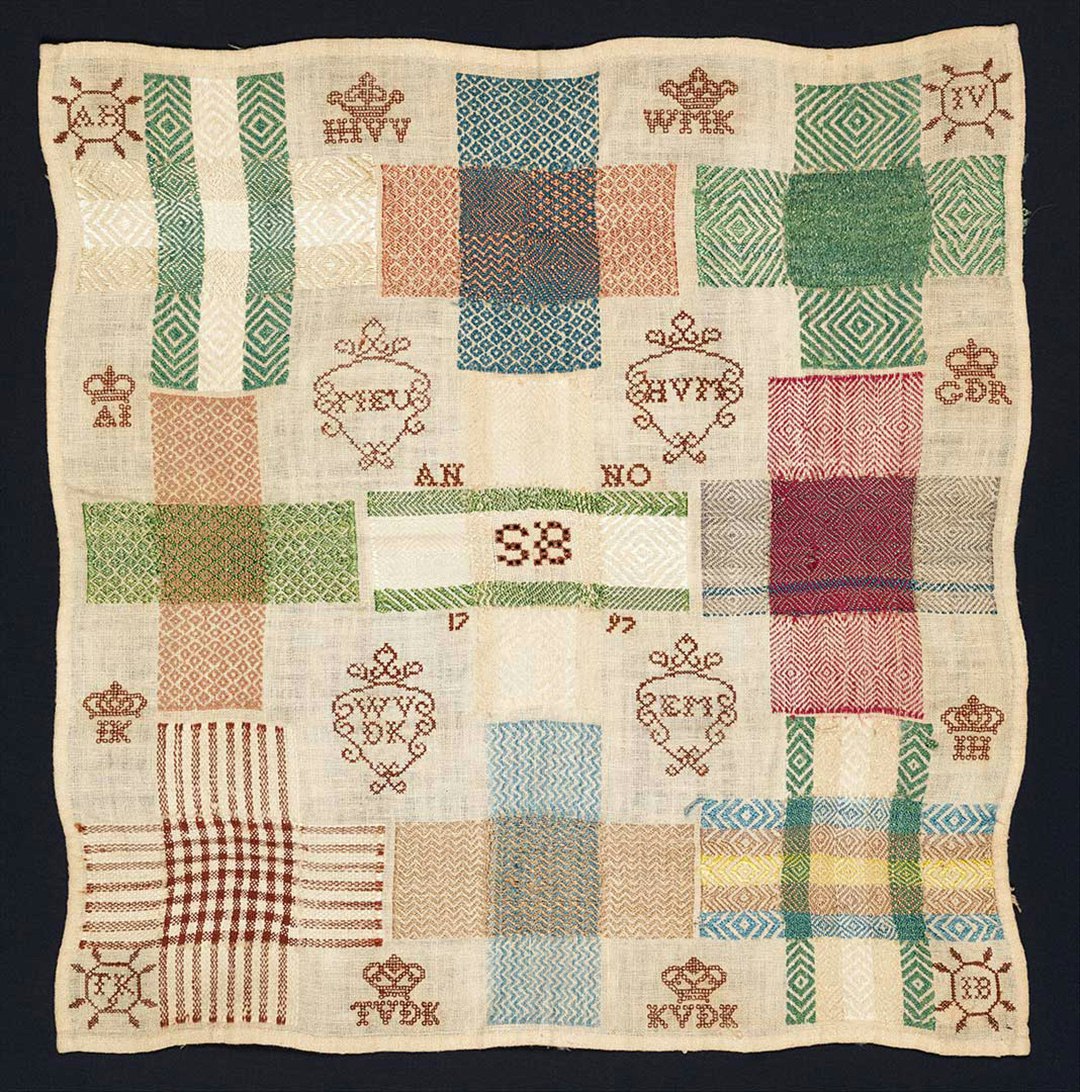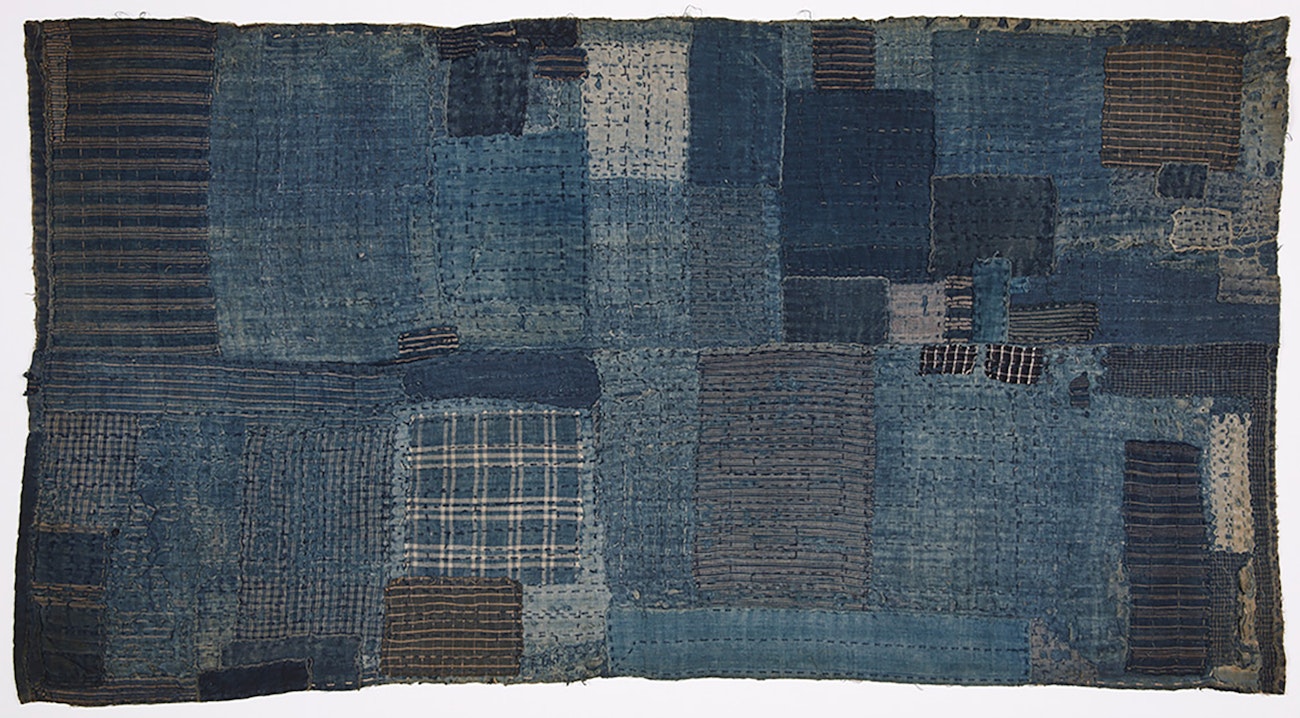I use vintage fabric in many of my mixed-media art projects. When a larger textile project is complete, I often end up with scraps of fabric. Instead of tossing out these scraps, I repurpose them by using them to make my stationery products, such as handmade journals, tags, and bookmarks. Recycling old fabric is an important part of my creative process, and I allow the previous life of the textiles to be visible.
Some traditional mending and repurposing traditions around the world are wonderfully visible, while others are a testament to the skill required to hide wear and age. Before mass manufacturing made it easier to purchase new fabric, mending fabric was an economic necessity. It was cheaper to mend an old garment or household linen than to buy or create a new one.
 Darning sample. Dutch, 1797. From the Collection of Mrs. Lathrop Colgate Harper, Bequest of Mabel Herbert Harper, 1957. Metropolitan Museum of Art. 57.122.150
Darning sample. Dutch, 1797. From the Collection of Mrs. Lathrop Colgate Harper, Bequest of Mabel Herbert Harper, 1957. Metropolitan Museum of Art. 57.122.150
Darning
In Europe, the process for mending fabric was called darning. Girls were taught how to make embroidery samplers from a young age. Some went further and made darning samplers, which taught them how to repair worn-out fabric, a skill crucial for every budding homemaker to have.
Darning samplers typically involved carefully filling each hole in a piece of fabric with a different interwoven pattern. It required considerable patience and skill to mend tattered fabrics such as household linen, hosiery, and garments to make them last for a long time. Although the darning was meant to be invisible, sometimes different colored threads were used to embellish the fabric. Girls used designs from samplers or pattern books to re-create the motif on the fabric they were mending. Often, the combination of technical and artistic skills resulted in both a practical and beautiful piece of work.
 Kantha bag. Collection of Linda Ligon. Photo by Matt Graves
Kantha bag. Collection of Linda Ligon. Photo by Matt Graves
Kantha
In parts of the Indian subcontinent, women create kantha textiles by stitching layers of old fabric into something new. Modern kantha artist Ekta Kaul states in PieceWork Fall 2020 that the word kantha means rags in Sanskrit, and it refers to a “form of flat, unwadded quilting” with a rippled surface. Women used old fabric such as saris to stitch everyday quilts, gifts for newborns, and elaborate pictorial works. The process could take several years, with the work of sewing a kantha passing from one generation to the next.
The traditional kantha stitch is a simple straight running stitch that is worked over the fabric. Kantha and other quilting traditions from the region might mix running stitch with darning stitch, pattern darning, and more.
 Child’s sleeping mat composed of several layers of indigo dyed cotton fabrics, patched and heavily stitched. Japan. Late nineteenth century. Museum purchase from General Acquisitions Endowment Fund. Cooper Hewitt, Smithsonian Design Museum Collection. 2017-15-1
Child’s sleeping mat composed of several layers of indigo dyed cotton fabrics, patched and heavily stitched. Japan. Late nineteenth century. Museum purchase from General Acquisitions Endowment Fund. Cooper Hewitt, Smithsonian Design Museum Collection. 2017-15-1
Boro
In Japan, peasant women used their own form of mending, creating boro cloth to preserve old fabric. Boro stems from the Japanese word boroboro, which means rags. The women employed a simple running stitch to repair old fabric and garments. The patches of scrap fabric used to cover the worn fabric were considered another part of the original garment’s history. They stitched together the patches to make the cloth stronger and in the process created something new. Unlike its European counterpart darning, the stitching in boro cloth is visible, adding new layers of history to old cloth.
Whether it was meant to be invisible or visible, practical or ornamental, mending old fabric requires great skill, dexterity, and artistry. These three traditions provide great examples of how simplicity, beauty, and creativity can still be used to preserve tattered but treasured fabric.
Interested in learning more about reusing and mending? Check out the Fall 2020 issue of PieceWork.
Also, remember that if you are an active subscriber to PieceWork magazine, you have unlimited access to previous issues, including Fall 2020. See our help center for the step-by-step process on how to access them.
Resources
- “Kantha,” House of Wandering Silk.org, www.wanderingsilk.org/kantha-history-and-meaning.
- Morrell, Anne. The Techniques of Indian Embroidery. Loveland, Colorado: Interweave Press, 1995.
- Ray, Mary. “Learn the Art of Japanese Boro for Garment Quilting.” Threads Magazine, February/March 2018. www.threadsmagazine.com/2018/03/22/boro-style.
- Nasim, Shahzeen. “Kantha: Reinventing Old Saris.” Cooper Hewitt, November 22, 2016. www.cooperhewitt.org/2016/11/22/kantha.
- Williamson, Liz, “Darning: A Visible Thread.” Textile Society of America Symposium Proceedings, 2004. 457. https://digitalcommons.unl.edu/tsaconf/457.
A. K. Fielding is a historian and artist who writes about early American history so she can buy materials to paint subjects from the same period. More information on her work is available on her website here.
Originally published July 27, 2020; updated August 15, 2022.

